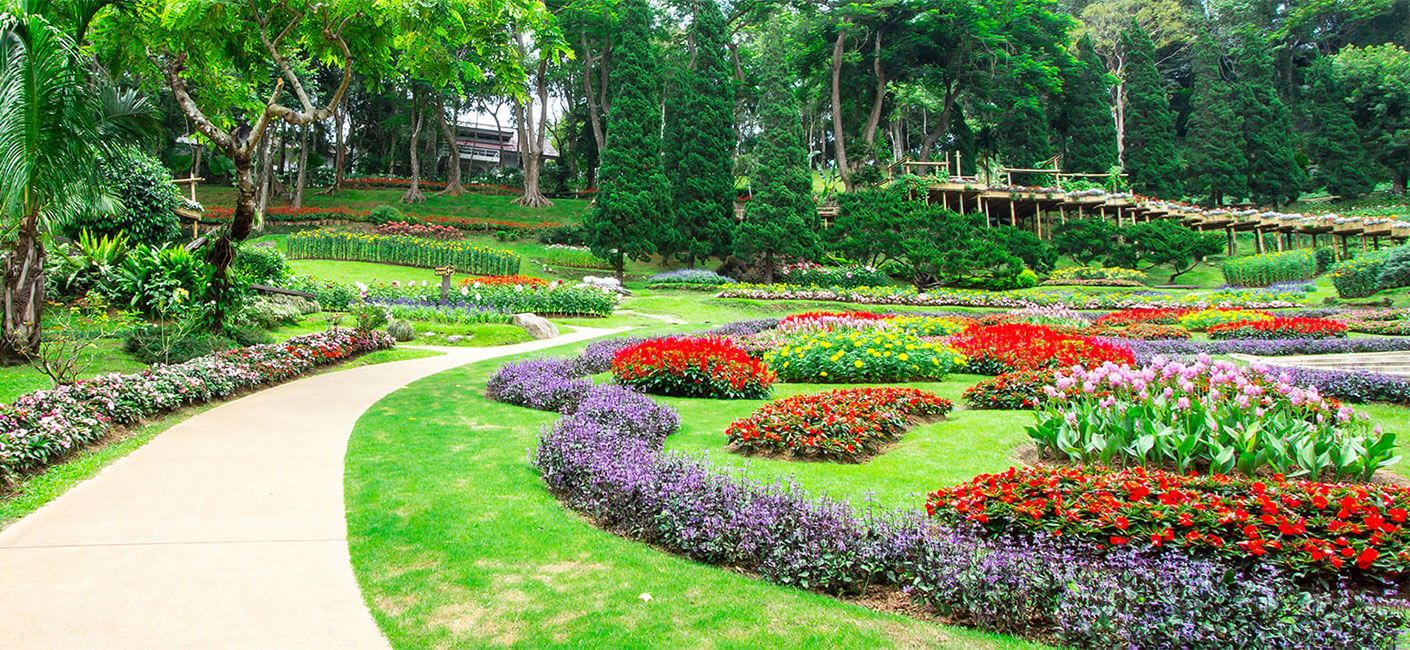The Enduring Allure of Ornamental Flowers: A Journey Through Beauty and History

Ornamental flowers, those vibrant splashes of color and delicate forms that grace our gardens, homes, and celebrations, hold a timeless appeal. More than just aesthetic additions, they represent a connection to nature, a celebration of beauty, and a reflection of cultural values. This article delves into the fascinating world of ornamental flowers, exploring their history, diversity, cultivation, and the enduring reasons for their popularity.
A History Rooted in Delight:
The human fascination with flowers dates back millennia. Evidence suggests that Neanderthals used flowers in burial rituals, indicating a symbolic understanding and appreciation of their beauty. Ancient civilizations, including the Egyptians, Greeks, and Romans, cultivated flowers for both practical and ornamental purposes. Egyptians used flowers in religious ceremonies, decorations, and even medicinal preparations. The Greeks associated specific flowers with gods and goddesses, while the Romans incorporated them into elaborate gardens and public spaces.
The Middle Ages saw a more practical approach to flower cultivation, primarily within monasteries and castles for medicinal and culinary purposes. However, the Renaissance witnessed a resurgence of interest in aesthetics and beauty, leading to the development of elaborate gardens featuring a wider variety of ornamental flowers.
The Age of Exploration brought a wave of new floral species from across the globe, dramatically expanding the palette available to European gardeners. The tulip craze of the 17th century in the Netherlands, known as "Tulip Mania," exemplifies the intense passion that ornamental flowers could ignite, albeit in an economically unsustainable way.
The Victorian era was characterized by elaborate floral arrangements and symbolism. Specific flowers were assigned meanings, allowing individuals to communicate messages through bouquets. This practice, known as floriography, added another layer of intrigue and romance to the appreciation of ornamental flowers.
Throughout the 20th and 21st centuries, advancements in horticulture and hybridization have led to an explosion of new varieties, offering an unprecedented range of colors, shapes, and sizes. Today, ornamental flowers are cultivated and enjoyed worldwide, reflecting diverse cultural preferences and aesthetic sensibilities.
A Kaleidoscope of Diversity:
The world of ornamental flowers is incredibly diverse, encompassing a vast array of species, cultivars, and hybrids. Categorizing them can be done in various ways, including:
By Growth Habit: This classification considers how the plant grows, including annuals (completing their life cycle in one year), biennials (completing their life cycle in two years), and perennials (living for more than two years). Examples include annual petunias, biennial sweet Williams, and perennial daylilies.
By Flower Structure: This focuses on the arrangement and characteristics of the flower itself. Examples include single flowers (like daisies), double flowers (like roses), and composite flowers (like sunflowers).

By Bloom Time: This considers the season in which the flower blooms, including spring-blooming tulips, summer-blooming zinnias, and fall-blooming chrysanthemums.

By Color: This is perhaps the most obvious classification, ranging from vibrant reds and oranges to calming blues and purples, and everything in between.
By Use: This considers how the flower is typically used, including cut flowers (like roses and lilies), bedding plants (like petunias and impatiens), and container plants (like geraniums and begonias).

Some popular examples of ornamental flowers include:
- Roses: Known for their beauty, fragrance, and wide range of colors.
- Tulips: Iconic spring flowers with vibrant colors and distinctive shapes.
- Lilies: Elegant and fragrant flowers often used in bouquets and arrangements.
- Orchids: Exotic and diverse flowers prized for their intricate shapes and long-lasting blooms.
- Sunflowers: Cheerful and iconic flowers that track the sun throughout the day.
- Petunias: Versatile annuals that provide a profusion of color in gardens and containers.
- Geraniums: Popular container plants known for their vibrant blooms and easy care.
- Daisies: Simple and cheerful flowers with a classic white and yellow appearance.
- Chrysanthemums: Fall-blooming flowers that provide a burst of color as the weather cools.
Cultivating Beauty: The Art and Science of Growing Ornamental Flowers:
Successful cultivation of ornamental flowers requires an understanding of their specific needs, including:
- Light: Different flowers require varying amounts of sunlight. Some thrive in full sun, while others prefer partial shade.
- Soil: Well-drained soil is crucial for most ornamental flowers. The specific soil type (sandy, loamy, or clay) may also be important.
- Water: Consistent watering is essential, but overwatering can lead to root rot. The frequency and amount of watering will depend on the plant, the climate, and the soil type.
- Fertilizer: Regular fertilization provides the nutrients necessary for healthy growth and abundant blooms.
- Pest and Disease Control: Monitoring plants for pests and diseases is crucial for preventing problems and ensuring healthy growth.
- Pruning and Deadheading: Pruning can help shape plants and encourage bushier growth, while deadheading (removing spent flowers) can promote continued blooming.
Modern horticulture has developed various techniques to improve the cultivation of ornamental flowers, including:
- Hybridization: Creating new varieties with desirable traits, such as increased disease resistance, longer bloom times, and unique colors.
- Tissue Culture: Propagating plants from small pieces of tissue, allowing for rapid multiplication and the production of disease-free plants.
- Greenhouse Cultivation: Growing plants in controlled environments, allowing for year-round production and protection from harsh weather.
The Enduring Appeal: Why We Love Ornamental Flowers:
The popularity of ornamental flowers stems from a variety of factors:
- Aesthetic Beauty: Flowers are inherently beautiful, with their vibrant colors, delicate shapes, and pleasing fragrances.
- Emotional Connection: Flowers evoke positive emotions, such as joy, happiness, and peace. They are often used to express love, sympathy, and gratitude.
- Symbolic Meaning: Flowers have long been associated with specific meanings, allowing them to communicate messages and express sentiments.
- Connection to Nature: Flowers provide a tangible connection to the natural world, bringing a sense of tranquility and beauty into our lives.
- Therapeutic Benefits: Studies have shown that being around flowers can reduce stress, improve mood, and promote overall well-being.
- Decorative Value: Flowers are used to decorate homes, gardens, and public spaces, adding beauty and enhancing the environment.
- Cultural Significance: Flowers play a significant role in many cultures, used in celebrations, ceremonies, and artistic expressions.
In conclusion, ornamental flowers are more than just pretty decorations; they are a testament to the enduring human desire for beauty, a connection to the natural world, and a powerful symbol of emotions and cultural values. From ancient civilizations to modern times, their allure remains strong, continuing to enrich our lives and brighten our world.
FAQ:
Q: What are the easiest ornamental flowers to grow for beginners?
A: Some easy-to-grow ornamental flowers for beginners include:
- Marigolds: Tolerant of various soil conditions and bloom profusely.
- Zinnias: Fast-growing and come in a wide range of colors.
- Sunflowers: Easy to start from seed and provide a stunning display.
- Cosmos: Low-maintenance and attract pollinators.
- Impatiens: Thrive in shade and provide continuous blooms.
Q: How do I choose the right ornamental flowers for my garden?
A: Consider the following factors when choosing ornamental flowers:
- Climate: Choose flowers that are well-suited to your local climate.
- Sunlight: Select flowers that thrive in the amount of sunlight your garden receives.
- Soil: Amend your soil as needed to provide the appropriate drainage and nutrients for your chosen flowers.
- Bloom Time: Choose flowers with staggered bloom times to enjoy continuous color throughout the growing season.
- Personal Preference: Select flowers that you find visually appealing and that complement your garden’s overall design.
Q: How do I prevent pests and diseases from affecting my ornamental flowers?
A: Here are some tips for preventing pests and diseases:
- Choose disease-resistant varieties: Select flowers that are known to be resistant to common diseases in your area.
- Provide good air circulation: Space plants adequately to allow for good air circulation, which can help prevent fungal diseases.
- Water properly: Avoid overwatering, which can create conditions that favor fungal growth.
- Monitor plants regularly: Check your plants regularly for signs of pests or diseases.
- Use organic pest control methods: Consider using organic pest control methods, such as insecticidal soap or neem oil, to control pests.
Q: What is deadheading, and why is it important?
A: Deadheading is the process of removing spent flowers from a plant. It is important because it encourages the plant to produce more blooms, rather than putting its energy into seed production.
Q: Can I grow ornamental flowers in containers?
A: Yes, many ornamental flowers can be successfully grown in containers. Choose containers that are appropriately sized for the plants and provide good drainage. Use a high-quality potting mix and fertilize regularly.
Conclusion:
The world of ornamental flowers is a rich and rewarding one, offering endless opportunities for beauty, creativity, and connection to nature. Whether you are a seasoned gardener or a beginner, exploring the diverse array of ornamental flowers and learning how to cultivate them can bring joy and satisfaction. By understanding their history, diversity, and cultivation needs, you can create stunning displays that enhance your surroundings and enrich your life. The enduring allure of ornamental flowers lies in their ability to evoke emotions, symbolize sentiments, and bring a touch of natural beauty into our world. So, embrace the beauty, cultivate the connection, and let the vibrant colors and delicate forms of ornamental flowers brighten your days.


